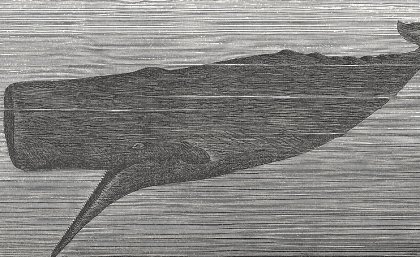
The idea that a sperm whale can use its massive head as a battering ram to sink ships has been hotly debated at least since Moby Dick was published in 1851.
University of Queensland researcher Dr Olga Panagiotopoulou, part of an international team researching the theory, says scientific evidence about the phenomenon remains scarce.
“The forehead of the sperm whale is one of the strangest structures in the animal kingdom,” said Dr Panagiotopoulou, an expert in the anatomy, bone biology and mechanics of large animals, including elephants and non-human primates.
“Internally, the whale’s forehead is composed of two large oil-filled sacs stacked on top of each other, known as the spermaceti organ and the junk sacs.
“The oil in the upper spermaceti organ was the main target of the whaling industry in the early 19th century.”
 Dr Panagiotopoulou (left) said male sperm whale heads were much larger than those of the females.
Dr Panagiotopoulou (left) said male sperm whale heads were much larger than those of the females.
“Such difference between the sexes are commonly found in species in which males fight to compete for females,” she said.
A 19th century whaler originally proposed the controversial hypothesis on the battering ram function of the sperm whale head.
“After a large male rammed and sank his ship in the Pacific in 1820, whaler Owen Chase described the whale’s head as admirably designed for this mode of attack,” Dr Panagiotopoulou said.
“The theory was instrumental in inspiring Herman Melville’s novel Moby Dick, but until our research, its mechanical feasibility had never been addressed.
“The scientific community received the ramming hypothesis with reluctance.
“This was mainly because the front part of the sperm whale head houses sensitive anatomical structures that are essential for sonar communication between whales, and they would be in harm’s way in a ramming event.
"Also not many people had actually observed sperm whales ramming.”
The researchers were intrigued and fascinated then to receive a report from a pilot and conservation researcher, who documented seeing sperm whales ramming while she was flying over the Gulf of California.
Professor David Carrier, from the University of Utah, said the sperm whale head had an important role in transmitting sonar clicks and potentially assisting in communication and buoyancy.
Still there was no explanation of how the sperm whale head could function as a weapon capable of sinking ships that are four to five times the mass of the whale, he said.
The interdisciplinary research team from Australia, the UK, the USA and Japan used structural engineering principles and computer models to test how the sperm whale’s head might withstand ramming impacts.
Dr Panagiotopoulou said the research showed that whale ramming events potentially could cause fatal fractures.
“But our findings show that connective tissue partitions within the junk of the sperm whale forehead may function as a shock absorber,” she said.
“This mechanism is important to reduce impact stress and protect the skull from failure.”
“The mechanical advantage of the junk’s structure may be the result of selection and acquired traits related to male-to-male aggressive behaviour,” she said.
“Male sperm whales may not fight frequently, but we know that aggressive ramming behaviour is a common characteristic in bottle nosed whales, killer whales, narwhales, pilot whales and the group of mammals from which whales are derived- the even-toed ungulates, such as goats.
“A closer look into the anatomy of the heads of other species that ram (such as monkeys and hippopotamuses) may reveal a variety of protective mechanisms.
“Our study has limitations but we hope it might stimulate future research to unravel the mechanical function of the head during head-butting events in other species, where aggressive behaviour has been observed but remains unmodelled.”
Dr Panagiotopoulou is the Head of the Moving Morphology and Functional Mechanics Laboratory in UQ’s School of Biomedical Sciences.
The research is published today in the biological and medical sciences journal PeerJ.
Contact: Dr Olga Panagiotopoulou, o.panagiotopoulou@uq.edu.au, +61 (7) 336 54443. Her website is here.










